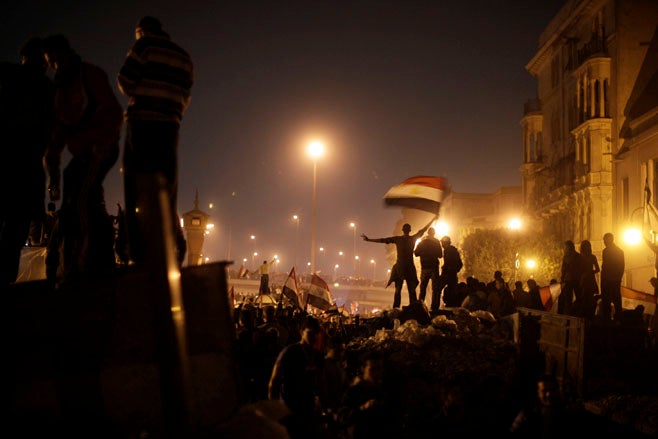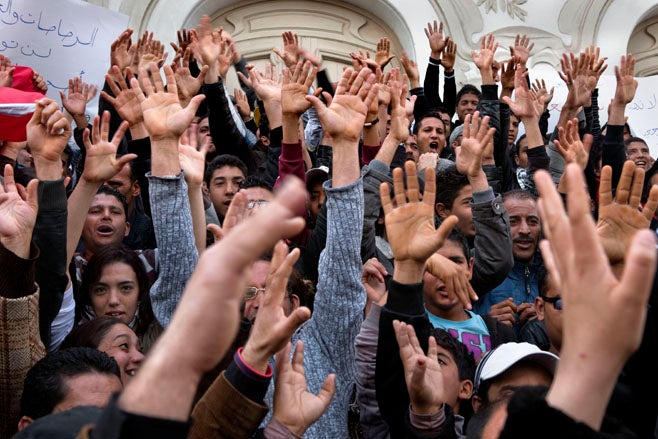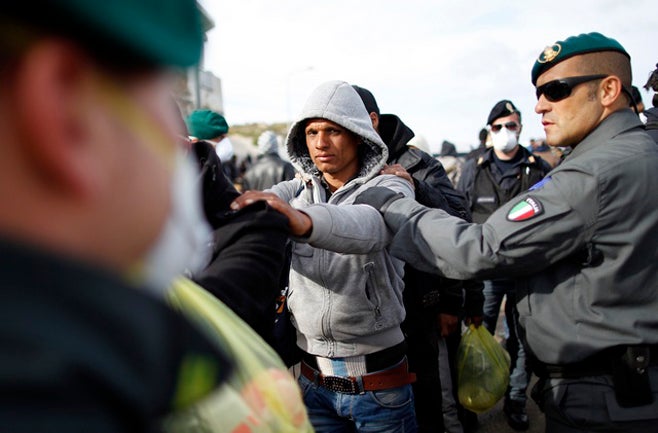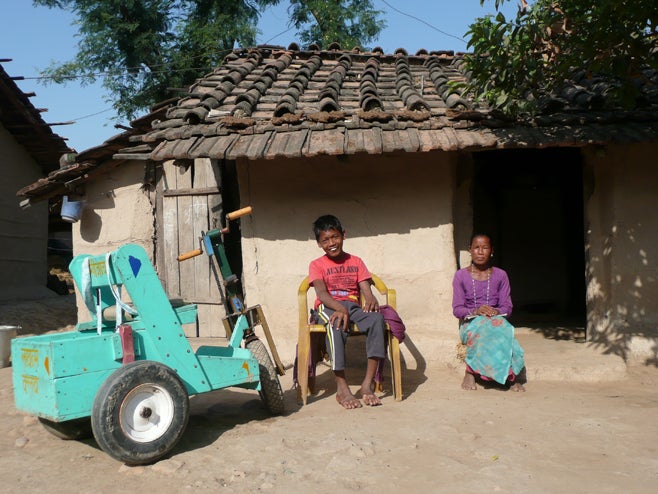The US incarcerates more people than any other country in the world, sometimes imposing very long sentences marred by racial disparities. Increasing numbers of non-citizens—363,000 in 2010—are held in immigration detention facilities, although many are not dangerous or at risk of absconding from immigration proceedings.
The federal government continues abusive counterterrorism policies, including detentions without charge at Guantanamo Bay, Cuba; fundamentally flawed military commissions; and effectively blocking lawsuits seeking redress for torture victims.
The US Census reported in 2011 that 46 million people live in poverty, the largest number in the 52 years for which poverty estimates have been published. Widespread poverty, its many intersections with racial and gender inequalities, and its disproportionate impact upon children and the elderly, raises serious human rights concerns.
Death Penalty and Extreme Criminal Punishments
In 2011 the state of Illinois joined 15 other states in abolishing the death penalty. Thirty-four states continue to allow its imposition. At this writing 39 people have been executed in 2011, continuing a downward trend from 2009, when 52 people were executed.
The state of Georgia executed Troy Davis on September 21, 2011, despite significant doubts about his guilt. Davis, who was sentenced to death for the 1989 murder of off-duty police officer Mark MacPhail, maintained his innocence until the last moment. The prosecution's case rested almost entirely on testimony from eyewitnesses, but seven of the nine who testified against Davis at his trial recanted and said they were no longer sure who shot MacPhail, and another three people said that another man confessed to the crime.
While the US Supreme Court held in 2010 that youth offenders under age 18 convicted of non-homicide crimes could not be sentenced to life without the possibility of parole, about 2,600 youth offenders continue to serve such a sentence for homicide-related crimes. State-level efforts continue to reform life without parole when sentencing youth. For example, California is slated in early 2012 to vote on a bill to allow reconsideration and resentencing of youth offenders serving life without parole.
Youth convicted of sex offenses in adult and juvenile courts also met with harsh treatment. July 2011 marked the deadline for all states and other jurisdictions to comply with the Adam Walsh Child Protection and Safety Act. The act requires jurisdictions to register people aged 14 and up convicted of certain sexual offenses on a national, publicly accessible, online registry. In some cases youth will be registered for life. The Department of Justice (DOJ) says 14 states have now substantially implemented the act.
Prison Conditions
The US continued to have the world’s largest incarcerated population at 2.3 million, and the world’s highest per capita incarceration rate at 752 inmates per 100,000 residents.
In December 2010 Human Rights Watch reported on the unnecessary pre-trial detention of thousands of people accused of minor crimes in New York City due to their inability to pay even small amounts of bail. Almost 90 percent of those arrested in 2008 for non-felony crimes who had bail set at US$1,000 or less were incarcerated pre-trial solely because they could not post bail.
The US Supreme Court decided in May that the state of California must reduce prison overcrowding. California prisons have failed to provide adequate medical and mental health care for decades, and a lower court panel found that prison under-staffing and severe overcrowding had led to such substandard care. The panel directed the state to significantly cut its prison population to improve care; the US Supreme Court agreed.
In February 2011 the DOJ issued its long-overdue proposed standards to implement the Prison Rape Elimination Act (PREA). While some standards meet the 2009 PREA Commission recommendations, several proposed standards are significantly weaker. For example, the proposed DOJ standards do not clearly require facilities to be staffed sufficiently to prevent, detect, and respond to the sexual abuse of prisoners. The standards would leave survivors of sexual assault without legal remedy because they were unable to comply with unduly strict internal grievance procedures. The proposed standards also explicitly exclude immigration detention facilities from coverage. At this writing the final PREA standards have not been issued.
This year Nevada, Hawaii, Idaho, and Rhode Island enacted laws restricting the shackling of pregnant prisoners, bringing the number of states with such laws to 14.
Racial Disparities in the Criminal Justice System
Racial and ethnic minorities continue to be disproportionately represented in the criminal justice system. Whites and African Americans engage in drug offenses at roughly equivalent rates, and African Americans account for only about 13 percent of the US population, yet African Americans comprised about 33 percent of all drug arrests in 2009. Not surprisingly, higher arrest rates lead to higher incarceration rates. For example, 45 percent of inmates in state prisons for drug offenses in 2009 were African American; only 27 percent were white.
Persons of color comprise 77 percent of all youth serving life without parole sentences. And for the first time in the country’s history in 2011, people of Latin American origin made up the majority of federal prisoners in the US, due to the federal government’s increased focus on prosecuting unauthorized immigrants.
African Americans have historically borne the burden of far harsher federal sentences for crack cocaine offenses compared to powder cocaine offenses. The Fair Sentencing Act, passed in August 2010, partially reduced these sentencing disparities. However the act was not explicitly retroactive. In June 2011 the US Sentencing Commission voted to make the new sentencing guidelines retroactive, so that 12,040 offenders are now eligible for reduced sentences.
Non-Citizens’ Rights
There are approximately 25.3 million non-citizens in the US, of which the government estimates 10.8 million are without authorization. Sixty-one percent of these unauthorized immigrants have lived in the US for 10 years or more.
In fiscal year 2010 US Immigration and Customs Enforcement (ICE) deported 387,242 non-citizens—over twice as many as in fiscal year 2000—and detained over 363,000 persons in immigration detention facilities, an increase of over 50 percent since fiscal year 2005. The unchecked expansion of immigration detention in the US over the past two decades has led to a nationwide detention system comprised of over 300 facilities, from small local jails to large, dedicated immigration detention facilities.
In June Human Rights Watch documented the vast numbers of detainees who are subjected to chaotic, frequent, and recurrent transfers between facilities. Between 1998 and 2010 there were over two million detainee transfers. Two hundred thousand detainees were transferred three or more times. On average, detainees were moved 370 miles between facilities, while a common transfer route between Pennsylvania and Texas covered 1,600 miles. The frequent transfers interfere with detainees’ access to counsel, witnesses, evidence, and family support.
In August the Department of Homeland Security (DHS) declared a fingerprint-sharing program mandatory, reversing prior policy. The Secure Communities program requires local law enforcement to share fingerprints with DHS, which claims that Secure Communities is used to identify and remove non-citizens convicted of serious crimes. However, 59 percent of those removed under the program between October 2008 and July 2011 had no criminal convictions or had convictions only for minor offenses, including traffic offenses. Several local law enforcement agencies and community groups across the country have vigorously opposed Secure Communities, arguing it impedes community policing and encourages racial profiling. DHS plans nationwide implementation by 2013.
In one of the few rights-protective immigration reforms in 2011, DHS announced that it will undertake case-by-case reviews of over 300,000 pending deportation cases and cases deemed to be low-priority will be administratively closed, allowing some potential deportees to remain in the country with temporary legal status. In identifying low-priority cases DHS will weigh non-citizens’ family and community ties, military service, and whether they arrived in the US as children.
Congress criticized the flaws in the country’s immigration system but failed to act. The Senate held a hearing in June on the DREAM Act, a bill that would grant legal status to non-citizens brought to the US as children, but it took no further action. The House of Representatives held several hearings on bills that would tighten border and visa security, require the detention of certain immigrants, and reduce both unauthorized and authorized immigration, but voted on none of these measures.
In April the Ninth Circuit Court of Appeals partially enjoined Arizona’s Senate Bill 1070 from going into effect. Governor Jan Brewer has appealed the decision to the US Supreme Court. Alabama surpassed Arizona in mid-2011 by passing what is likely the country’s strictest state-level immigration measure. The law criminalizes transporting or renting to an unauthorized immigrant and requires public schools to document their students’ immigration status, among other measures. The Alabama law has also been temporarily partially enjoined, as have similarly problematic laws in Utah, Indiana, and Georgia. Nevertheless, appeals courts allowed several problematic provisions in the Alabama law to go into effect.
Labor Rights
US workers continue to face severe obstacles in forming and joining trade unions, and the federal government and many state governments are failing to meet their international obligations to protect the free exercise of these rights. Several states—including Arizona, Indiana, Michigan, New Hampshire, Ohio, Oklahoma, and Wisconsin—placed severe restrictions in 2011 on workers’ rights to bargain collectively.
Hundreds of thousands of children work on US farms. The 1938 Fair Labor Standards Act specifically exempts farmworker children from the minimum age and maximum hour requirements that apply to all other working children, exposing them to work at younger ages, for longer hours, and under more hazardous conditions. As a result, child farmworkers, most of who are of Latin American descent, often work 10 or more hours a day and risk pesticide poisoning, heat illness, injuries, life-long disabilities, and death. More than half of all working children who suffered fatal occupational injuries in 2010 worked in crop production, up from previous years. Many child farmworkers drop out of school, and girls are sometimes subjected to sexual harassment. Federal protections that do exist are often not enforced: agricultural inspections and child labor law violations declined in 2010. Notably, in August the Department of Labor proposed to expand the list of hazardous agricultural tasks prohibited for children under age 16. (Outside agriculture federal law bans hazardous work for children under age 18).
Millions of US workers, including parents of infants, are harmed by weak or non-existent laws on paid leave, breastfeeding accommodation, and discrimination against workers with family responsibilities. A February 2011 Human Rights Watch report showed that having scarce or no paid leave contributed to delaying babies’ immunizations, postpartum depression, and other health problems, and caused mothers to stop breastfeeding early.
Health Policy
HIV infections in the US continued to rise at an alarming rate in 2011, particularly in minority communities. Many states continue to undermine human rights and public health with restrictions on sex education, inadequate legal protections for HIV-positive persons, resistance to harm-reduction programs such as syringe exchanges, and failure to fund HIV prevention and care. Human Rights Watch reported in 2011 on state laws and policies that are blocking access to HIV treatment and services in Mississippi, where half of those testing positive for HIV are not in care and the death rate from AIDS is 60 percent higher than the national average. Human Rights Watch also highlighted the struggle to expand syringe access to injection drug users in North Carolina, where laws criminalizing syringe possession are forcing exchange programs to operate underground and advocates to risk arrest on a daily basis.
Women’s and Girls’ Rights
In a 2011 decision the Inter-American Commission on Human Rights ruled that the US violated the American Declaration of the Rights and Duties of Man when the government failed to enforce a restraining order obtained by a wife against an abusive husband who abducted the couple’s daughters in Colorado in 1999. The commission recommended that the US make enforcement of protection orders mandatory, adopt protection measures for children in domestic violence situations, and better train officials on domestic violence prevention and response.
The US Supreme Court ruled in June 2011 that 1.5 million women employees of Walmart could not constitute a class for a class action suit against the corporation for discrimination in pay and advancement opportunities. The decision calls into question the viability of large-scale gender discrimination suits in the US, where women earn an average of 77 cents for every dollar earned by men.
Rights relating to abortion access continued to be heavily contested in 2011, with fights at the state and national levels over insurance coverage for abortion and over patients’ rights to information and services. Federal judges ruled against laws in Baltimore and New York City that would have required “crisis pregnancy centers” to inform clients that they do not provide abortions or certain methods of contraception.
Sexual Orientation and Gender Identity
US law offers no protection against discrimination based on sexual orientation or gender identity. In December 2010 President Barack Obama signed the “Don’t Ask, Don’t Tell Repeal Act of 2010,” which repealed the discriminatory policy barring gays and lesbians from serving openly in the US military, pending military review. The repeal went into effect in September 2011.
The Defense of Marriage Act continues to bar recognition of same-sex marriage at the federal level. However, in February the DOJ informed Congress that it would not continue defending in the courts the constitutionality of the provision that defines “marriage” as a legal union between one man and one woman.
Same-sex marriages are not recognized or performed in forty-one states. In June New York state passed the Marriage Equality Act, becoming the sixth and largest state (Washington, DC, is the seventh jurisdiction) to grant these marriage licenses. At this writing the California Supreme Court was considering jurisdictional questions raised by a challenge to a district court decision that California’s 2008 same-sex marriage ban (Proposition 8) was unconstitutional.
Hawaii, Connecticut, and Nevada passed measures to ban employment discrimination based on sexual orientation or gender identity. In August a federal appeals court upheld a lower court’s decision that declared unconstitutional a Wisconsin law barring transgender inmates from receiving hormone therapy or sex reassignment surgery, even when medically necessary.
Disability Rights
According to the US government, persons with disabilities are almost twice as likely as those without disabilities to be victims of violence.While the 2009Matthew Shepard and James Byrd Hate Crime Prevention Act increased awareness of hate crimes against people with disabilities, underreporting of these crimes remains a concern.
Counterterrorism
Despite overwhelming evidence that senior Bush administration officials approved illegal interrogation methods involving torture and other ill-treatment after September 11, 2001, the Obama administration failed to criminally investigate high-level officials or to establish a commission of inquiry.
A long-awaited investigation by Special Prosecutor John Durham concluded that further criminal investigation was warranted only with respect to the deaths in custody of two detainees, but there have been no investigations into hundredsof other instances of detainee abuse.The Obama administration continued to invoke an overly broad interpretation of the “state secrets” privilege in civil suits brought by current and former detainees alleging abuse, further limiting a possible avenue for redress for victims of torture and other ill-treatment.
In December 2010 Congress enacted funding restrictions limiting the administration’s ability to repatriate and resettle Guantanamo detainees. The only detainee transferred in 2011 was sent against his will to Algeria where he feared he would be tortured. While Human Rights Watch has not received reports of abuse since his return, the US refused to allow an independent arbiter to review his claim of fear of torture.
In March 2011 Obama signed an executive order establishing a periodic administrative review system for detainees currently held at Guantanamo and either designated for indefinite detention, or for trial but not yet facing charges. At this writing no implementing regulations have been issued.
Proposed legislation in Congress seeks to expand US domestic authority to detain alleged terrorism suspects indefinitely without charge and to mandate military detention for a certain category of terrorism suspects. In February a detainee pled guilty before a military commission and was sentenced to 34 months, conditioned upon his continued cooperation with the government, or 14 years otherwise.
The military commission appellate court ruled in two cases that military commissions have jurisdiction over conspiracy and material support for terrorism, crimes that have never previously been considered as war crimes under international law. In April 2011 Attorney General Eric Holder announced that he had reversed his earlier decision to prosecute the five men accused of plotting the 9/11 attacks in federal court and would instead try them before a military commission. Charges were sworn against the five men. Charges were also referred against the man accused of plotting the bombing of the USS Cole in Yemen in October 2000; he was arraigned in November before a military commission.
The Obama administration announced in July 2011 that it had captured a terrorism suspect off the coast of Somalia and detained him on a ship for nearly two months before the International Committee of the Red Cross was allowed to visit him in detention. He was later transferred to New York for prosecution in federal court.
In May 2011 a team of US Navy SEALS killed al Qaeda leader Osama bin Laden in Abbotabad, Pakistan. In September Anwar al Awlaki, a cleric with US citizenship who Obama described as the “leader of external operations” for al Qaeda in the Arabian Peninsula (AQAP), was killed by a US-operated drone strike in Yemen. Another US citizen, Samir Khan, who was the editor of AQAP’s online magazine Inspire, was killed in the same strike. In October a drone attack killed Awlaki’s 16-year-old son, along with several others; the US has said the son was not the target. Despite calls for greater transparency, the US continues to be vague about the legal justifications for these killings and about who can be targeted, when, and under what conditions.
In September Human Rights Watch uncovered a cache of documents in Tripoli that detailed the CIA’s role in the rendition of terrorism suspects to Libya, as well as its role in questioning those suspects once in Libya. The CIA participated in these actions despite overwhelming evidence at the time that the suspects would likely face torture.






